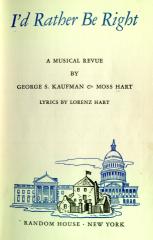Book Review: I'd Rather be Right

I'd Rather Be Right
A Musical Revue
by George S. Kaufman & Moss Hart
Lyrics by Lorenz Hart
Hardcover: New York: Random House, 1937. 4 plates.
Well printed on acid-free paper, so should remain in good shape if
properly stored. Music composed and written by Richard Rodgers and Lorenz
Hart, separately published.
I first discovered this musical after watching James Cagney perform the
showstopper "Off the Record" song-and-dance routine in
Yankee Doodle Dandy. That biopic of songwriter and performer George M.
Cohan is a fabulous film, using Hollywood’s best showmanship to string a
bunch of songs together into a rousingly patriotic plot that was just the
ticket in 1942.
I'd Rather Be Right doesn’t exactly have the timeless appeal of the classic musicals. It’s too much a creature of the 1930s, and the show numbers focus on Broadway glitz rather than emotion. The snippet in Yankee Doodle Dandy might well be the only piece you’ll see acted out. A collapsed version of the musical, sans score, can be found in this book.
Great Depression humor
It's a quick read, and what emerges is a bit of light comedy that is firmly rooted in the era. The jokes aren't very deep, but they are snappy and come one after another. If you have a firm grasp of American history, you’ll appreciate them all the better. The stage direction show the authors to be very aware of the artificiality of the musical comedy:
- And the CABINET enters — all ten of them. Singing, of course — it's a well-known fact that the CABINET always sings when it gets together for a meeting. (p. 22)
- Into the scene — suddenly, and for no apparent reason — there stroll a dozen or more beautiful girls, in gay musical-comedy costumes that were never designed for just strolling through a park. (p. 52)
The plot is there just to stitch the music together. Two young lovers in New York City would like to get married, but the boy needs a raise before he can support a wife, and his boss won't give it to him until the federal budget is balanced. President Roosevelt strides through their dream in Central Park, followed by government officials, the Cabinet, the Supreme Court, and even defeated candidate Al Landon. Along the way, we get jokes about the federal interventions in the economy. Not only are there millionaires now working for the WPA, but President Roosevelt finds himself using the Wagner Act to mediate a wage dispute between a merry-go-round owner and employee.
Some of the jokes can apply to any time period. The Cabinet members react angrily to a suggestion to balance the budget, then sighing in relief when President Roosevelt asks them what new taxes they can think of. Postmaster-General Farley suggests charging all letters at airmail rates. As he explains, "They wouldn't go air mail – we’d just send them the regular way. But it would double the revenue." Then there's the balloon vendor reciting off a list of taxes that he has to pay, popping a balloon each time he names a tax.
There are also jokes that draw on the historical context. Treasury Secretary Henry Morgenthau talks about paying $35 for $21 worth of gold, referring to the devaluation of the dollar. Labor Secretary Frances Perkins, the first woman to sit on the Cabinet, is depicted with the condescension often reserved for brainy women in period fiction. She comes up with stupid ideas, gets treated dismissively by the other cabinet members, and finally Roosevelt says, "You know, sometimes I think a woman's place is in the home. We even get references to the famous beard worn by Chief Justice Charles Evans Hughes.
Many of the popular culture references no longer make sense, as they haven’t made it into the history books. Case in point: "That was all Jim Farley. He could have elected Parkyakarkus." But the glimpses we get into daily life are intriguing for their contrast to today. The two lovers spread out newspapers to sit on in the park; blankets are de rigeur today. The Cabinet gets ideas for balancing the budget from watching Marx Brothers comedies. And Roosevelt's fireside address is sponsored by Lady Esther face cream.
It's a gentler style of comedy than we’re used to, one with a fair number of gee-whiz moments. As Roosevelt buys the kids an ice cream, we get Peggy exclaiming, "My, I never thought I'd be eating ice cream with the President of the United States." Roosevelt pulls out a little red notebook containing the federal budget. Underneath the line for "Two battleships, a hundred and fifty million dollars,” FDR jots down, “Ice cream, twenty-five cents." There's also some unintentional humor, as when the Cabinet discusses a third term with Roosevelt. Of course, this was 1937, so it’s intended only as a bit of zany fun. In a similar vein is when the Supreme Court declares the Constitution unconstitutional. (The “switch in time that saved nine” had only occurred recently.)
The stage directions describe the song-and-dance numbers with such breathless enthusiasm that one is disappointed to turn the page and find them missing. Off the Record actually turns out to be a disappointment in this book. The lyrics are more restrained than Cohan's unauthorized opening-night lyrics, which are presented in Yankee Doodle Dandy with an additional wartime verse. Perhaps it’s just as well that we only see excerpts of this play in that film, for those are the most exciting portions.